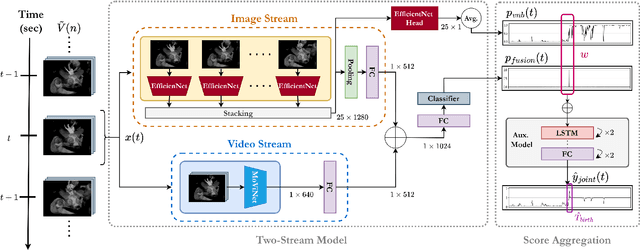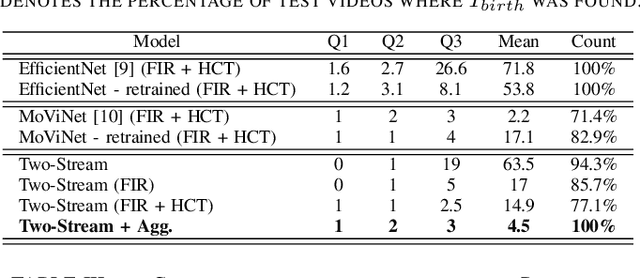Siren Rettedal
Two-Stream Thermal Imaging Fusion for Enhanced Time of Birth Detection in Neonatal Care
Mar 05, 2025



Abstract:Around 10% of newborns require some help to initiate breathing, and 5\% need ventilation assistance. Accurate Time of Birth (ToB) documentation is essential for optimizing neonatal care, as timely interventions are vital for proper resuscitation. However, current clinical methods for recording ToB often rely on manual processes, which can be prone to inaccuracies. In this study, we present a novel two-stream fusion system that combines the power of image and video analysis to accurately detect the ToB from thermal recordings in the delivery room and operating theater. By integrating static and dynamic streams, our approach captures richer birth-related spatiotemporal features, leading to more robust and precise ToB estimation. We demonstrate that this synergy between data modalities enhances performance over single-stream approaches. Our system achieves 95.7% precision and 84.8% recall in detecting birth within short video clips. Additionally, with the help of a score aggregation module, it successfully identifies ToB in 100% of test cases, with a median absolute error of 2 seconds and an absolute mean deviation of 4.5 seconds compared to manual annotations.
AI-Based Thermal Video Analysis in Privacy-Preserving Healthcare: A Case Study on Detecting Time of Birth
Feb 05, 2025Abstract:Approximately 10% of newborns need some assistance to start breathing and 5\% proper ventilation. It is crucial that interventions are initiated as soon as possible after birth. Accurate documentation of Time of Birth (ToB) is thereby essential for documenting and improving newborn resuscitation performance. However, current clinical practices rely on manual recording of ToB, typically with minute precision. In this study, we present an AI-driven, video-based system for automated ToB detection using thermal imaging, designed to preserve the privacy of healthcare providers and mothers by avoiding the use of identifiable visual data. Our approach achieves 91.4% precision and 97.4% recall in detecting ToB within thermal video clips during performance evaluation. Additionally, our system successfully identifies ToB in 96% of test cases with an absolute median deviation of 1 second compared to manual annotations. This method offers a reliable solution for improving ToB documentation and enhancing newborn resuscitation outcomes.
Advancing Newborn Care: Precise Birth Time Detection Using AI-Driven Thermal Imaging with Adaptive Normalization
Oct 14, 2024Abstract:Around 5-10\% of newborns need assistance to start breathing. Currently, there is a lack of evidence-based research, objective data collection, and opportunities for learning from real newborn resuscitation emergency events. Generating and evaluating automated newborn resuscitation algorithm activity timelines relative to the Time of Birth (ToB) offers a promising opportunity to enhance newborn care practices. Given the importance of prompt resuscitation interventions within the "golden minute" after birth, having an accurate ToB with second precision is essential for effective subsequent analysis of newborn resuscitation episodes. Instead, ToB is generally registered manually, often with minute precision, making the process inefficient and susceptible to error and imprecision. In this work, we explore the fusion of Artificial Intelligence (AI) and thermal imaging to develop the first AI-driven ToB detector. The use of temperature information offers a promising alternative to detect the newborn while respecting the privacy of healthcare providers and mothers. However, the frequent inconsistencies in thermal measurements, especially in a multi-camera setup, make normalization strategies critical. Our methodology involves a three-step process: first, we propose an adaptive normalization method based on Gaussian mixture models (GMM) to mitigate issues related to temperature variations; second, we implement and deploy an AI model to detect the presence of the newborn within the thermal video frames; and third, we evaluate and post-process the model's predictions to estimate the ToB. A precision of 88.1\% and a recall of 89.3\% are reported in the detection of the newborn within thermal frames during performance evaluation. Our approach achieves an absolute median deviation of 2.7 seconds in estimating the ToB relative to the manual annotations.
 Add to Chrome
Add to Chrome Add to Firefox
Add to Firefox Add to Edge
Add to Edge